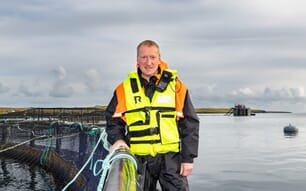Speaking at thethirteenth Annual Conference of the European Association of Fish Pathologists (EAFP) hosted in Grado, Italy, last Autumn, the Director of Schering Plough's Global Aquaculture new business development/feasibility unit, was also awarded honorary membership of the organisation in recognition of his lifelong work for aquatic animal health.
 |
| Professor Patrick Smith of Schering Plough, presenting his plenary lecture during the EAFP Annual Conference in Italy. |
In his plenary session lecture - 'Fish vaccines - a short but remarkable journey', Professor Smith highlighted the major benefits now derived from a continual commitment to research.
His paper documented three decades of rapid and innovative progress in vaccine development - the products of which he believed now protect and sustain economic production across the globe.
Professor Smith also acknowledged the importance of developing experience and techniques. They will have enormous potential to meet the challenge of endemic disease well into the future, he said.
The plenary lecture mapped progress from the 1970s, when the first vaccines for ERM and Vibrio anguillarum became available in the USA. These were followed with the release of Furunculosis vaccines in Europe in the 1980s. He confirmed that there are now more than 24 commercial vaccines available for the prevention of a wide range of diseases with many more in development.
Enormous Potential
The potential from vaccines for lower mortality, improved growth efficiency and higher yields is now a critical factor in disease management programmes.
Through feed back from large scale operations, the economic benefits derived from available vaccines are now thought to be worth hundreds of millions of pounds per year to world markets. Vaccine producers, such as Schering-Plough, commit extensive resources to develop new vaccine technology in immunological capability as well as their delivery methods. The availability of vaccines in immersion, injection and oral forms now offers a wide range of options to suit production systems. The overriding priority requires new solutions to be effective, economic and safe.
Professor Smith demonstrated the tangible results achieved from continuous and ongoing research and underlined the value of a symbiotic relationship between developing science and commercial production. The message was clear that we are possibly only at the first stop on this remarkable journey. In addition to his lecture Professor Smith chaired the Fish Vaccines and Vaccination session.
Dr. David Alderman, president of the EAFP, presented Professor Smith with his honorary membership of the EAFP. This honour is only the eleventh to be awarded by the 1000-member Association in its 28 year history.
SP Poster Winners
Schering-Plough, which sponsored this year's conference, has been involved with the EAFP since 1982. At this year's event it funded additional delegate places through its bursary awards. This initiative enables selected student visitors to meet some of their costs associated with attending the conference. The company also sponsored a poster competition which drew more than 250 entries The organisers named three joint winners.
- M Khalil, H Hurd and D Hoole from the Centre for Applied Entomology and Parasitology, ISTM, Keele University Their topic was the differential susceptibility of the different stages within the life cycle of the cestode, Bothriocephalus acheilognathi to cadmium pollution.
- D Smail, K Lester and M Monte from the Fisheries Research Services, Aberdeen, and University of Aberdeen. Their poster focussed on strain sub-typing of Scottish isolates of Salmonid Alphavirus (SAV) using IFAT and DOT BLOT.
- AB Olsen, N Sandlund, H Rudra and H Mikkelsen of the National Veterinary Institute Bergen, Norway, Institute of Marine Research, Bergen, Norway and Norwegian Institute of Fisheries and Aquaculture Research, Troms, Norway. Their topic was on the transmission experiment in Atlantic salmon (Salmo salar L.) inducing skin ulcer infection with Tenacibaculum-like bacteria.


